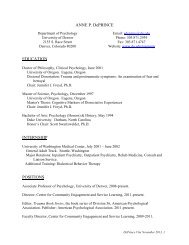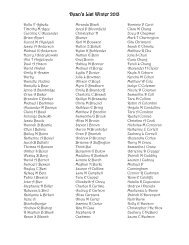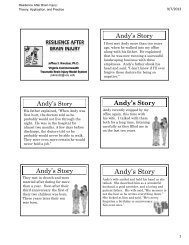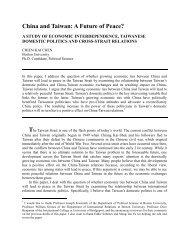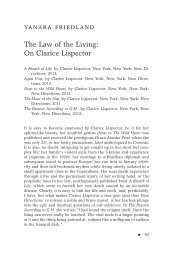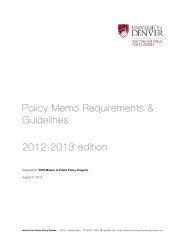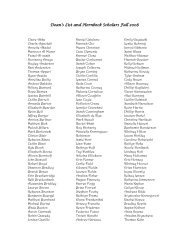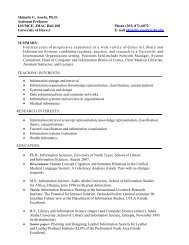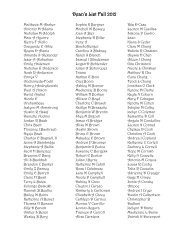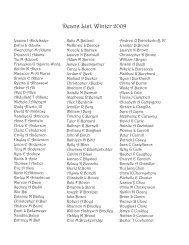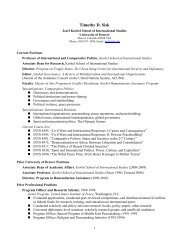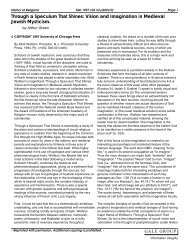You also want an ePaper? Increase the reach of your titles
YUMPU automatically turns print PDFs into web optimized ePapers that Google loves.
Where in theWorld is <strong>GSSW</strong>?<br />
Kenya<br />
land, eating the fresh foods provided to<br />
them naturally by their environment.<br />
Now they grow corn in poor soil, pay for<br />
their water and keep chickens in coops.<br />
In less than 100 years, their entire way<br />
<strong>of</strong> life has been completely changed. A<br />
large portion <strong>of</strong> their cultural identity<br />
was connected with the land and the<br />
animals that surrounded them.<br />
There are many parallels between the<br />
way the American government and the<br />
Kenyan government have treated the<br />
people native to their countries. As a<br />
result, the Watha and Native Americans<br />
have a great deal in common. Because<br />
they have experienced historical<br />
trauma and displacement, many<br />
native Kenyan people today live in<br />
poverty and out <strong>of</strong> harmony with<br />
their environment.<br />
The Watha are experiencing more<br />
than just displacement from their<br />
original homelands. They are also<br />
seeing the degradation <strong>of</strong> elephants<br />
and rhinos, with which they used to<br />
live in harmony. Poaching has risen<br />
within the last 60 years, reaching<br />
an all-time high in 2011. For the Watha, the killing <strong>of</strong> an elephant<br />
or rhino always had deep cultural meaning; the animal’s life was<br />
respected, and every portion <strong>of</strong> its body was used. Now the Watha<br />
see these sacred animals left to rot with only a fraction <strong>of</strong> their<br />
bodies taken away. Some community members have themselves<br />
resorted to poaching other herd animals, like impala or water<br />
buffalo, because their crops are not generating sufficient income.<br />
Traveling to Africa and working side-by-side with the Watha<br />
helped me gain perspective on the deep connection between<br />
the environment and social work. Conservation <strong>of</strong> our planet is<br />
imperative for the success <strong>of</strong> humans as a species—who happen<br />
to make up much <strong>of</strong> our client base. As social workers, I believe<br />
that if we are committed to conservation in the same way we are<br />
committed to our clients, we will see a drastic improvement in<br />
both our social and environmental surroundings.<br />
Click here to read student and faculty blogs from Kenya.<br />
14 spring 12 where in the world is <strong>GSSW</strong>?<br />
An Africa That Never Was<br />
by Jane Boone, MSW ’11<br />
Director <strong>of</strong> Pawsitive Connection, a Freedom Service Dogs program<br />
Africa holds a place in my mind that is one part fantasy, one part<br />
history and one part reality. My journey into our modern day Heart<br />
<strong>of</strong> Darkness began with a book. No, not that book, but rather a<br />
series <strong>of</strong> fiction that swept Africa’s lands and rich history. I was<br />
drawn into these narratives and images <strong>of</strong> desolate sand dunes,<br />
rich dense jungles, and people who spoke languages that sounded<br />
like nothing I had ever heard. I was captured by a history that was<br />
fabulous in its brutality—and an Africa was born in my mind that<br />
held within its borders the last place on earth that was untouched,<br />
unsullied, un-Americanized.<br />
The real Africa is not the Africa <strong>of</strong> my dreams. It is a land that <strong>of</strong>fers<br />
so many dichotomous images that it can be almost impossible to<br />
wrap my head around this “real” Africa. The Africa that I came to<br />
know through two trips to this incredible continent was an Africa<br />
where I could pet lions and drink Coke; where I drove in cars down<br />
roads lined with baboons; where the people sang and danced ancient<br />
rituals wearing Nike t-shirts. This is the real Africa, and it is a place<br />
that is not without flaws. This discovery created a new Africa for<br />
me. Out <strong>of</strong> the shattered pieces <strong>of</strong> my idealized perspective came a<br />
new understanding and a greater appreciation.<br />
I traveled to Kenya in the winter <strong>of</strong> 2010 with a group from the<br />
Graduate School <strong>of</strong> Social Work at the <strong>University</strong> <strong>of</strong> <strong>Denver</strong>. We<br />
came to study conservation social work, but in my heart was the<br />
knowledge that I was traveling thousands <strong>of</strong> miles to live and<br />
breathe Africa, and for me Africa is indistinguishable from its<br />
animals; they are one and the same. What I found was a country<br />
that was bitterly pitted against the one thing that defines it in<br />
my mind. Kenya—the lion king, the great migration, the animals<br />
—was waging a war. People plagued by animals who are plagued<br />
by people. This idea was at first baffling. How could elephants in<br />
your backyard possibly be a bad thing? How could these people not<br />
see the beauty that surrounded them?<br />
During our trip we traveled to a rural village at the foot <strong>of</strong> Mt.<br />
Kasigau to visit the Rukanga people. It was this place—these<br />
people—that define the contradictions that I struggle to unify in<br />
my mind. I was the first to step <strong>of</strong>f the bus as we pulled up to the<br />
community center. The view <strong>of</strong> Mt. Kasigau was exquisite—one<br />
<strong>of</strong> the most beautiful places I had ever been. It seemed that the<br />
moment my feet touched the ground, I found myself in the arms<br />
<strong>of</strong> a very enthusiastic, singing, black woman. I was swept up in a<br />
series <strong>of</strong> hugs, kisses, tears and exclamations, most <strong>of</strong> which I could<br />
not understand. It was a greeting that I will never forget, and I felt as though I had<br />
found a mythical people in an untouched place.<br />
We spent about four days with the Rukanga people, and not all <strong>of</strong> it was as<br />
magical as that first moment. Our last meal—one that had been prepared for us<br />
at what I can only imagine was great expense—was a celebration, a goodbye, a<br />
thank you for our work there. We were seated in a semi-circle watching as the<br />
women put the finishing touches on the meal, and a stray dog wandered into<br />
the circle, drawn by the smell <strong>of</strong> the food. A man, a member <strong>of</strong> my mythical<br />
imaginings, took a stick and hit the dog, chasing him away. Tears welled up in<br />
my eyes—a hysterical desire to run to the dog and protect it taking shape in<br />
my thoughts. I forced myself to remain seated, to bow my head and control my<br />
tears, to laugh along with my peers. But this moment created a rift—how to<br />
knit together the image <strong>of</strong> that first welcome, that beautiful moment, with this<br />
single act <strong>of</strong> cruelty? To me, that place, those people and that experience, have<br />
come to define Africa: a continent <strong>of</strong> great beauty,<br />
filled with beautiful people and rife with cruelties.<br />
Although that moment lives on in my mind as a type<br />
<strong>of</strong> reality check when I get too nostalgic about an<br />
Africa that exists only in fiction, it does not change<br />
my deep love for Kenya. In fact, what I took away<br />
from that trip was so much more than the sum <strong>of</strong> its<br />
parts. No moment or single experience can describe<br />
what I took with me when I left.<br />
When I think back on our 14 days traveling both<br />
across the land, and sometimes back through time,<br />
I remember the bristling feeling <strong>of</strong> the elephants we<br />
played with and how their drooping eyes seemed<br />
to look straight through me. I remember walking<br />
through the bush sharing ideas and exchanging Boone learns the intricacies <strong>of</strong> using sisal to weave<br />
thoughts with the ANAW (Africa Network for baskets, an eco-friendly means <strong>of</strong> generating income<br />
because sisal can easily be replanted.<br />
Animal Welfare) staff. I can remember the feeling<br />
<strong>of</strong> being surrounded by the sounds <strong>of</strong> the night and<br />
how it made me snuggle further down into my blanket. I remember being in<br />
the homes <strong>of</strong> the families we visited, and seeing beauty in the simplicity <strong>of</strong><br />
their lifestyle while at the same time being thankful for all the conveniences<br />
I have at my fingertips. I remember walking through the slum—the smell, the<br />
claustrophobia, the faces <strong>of</strong> the children staring at us.<br />
Although my perception <strong>of</strong> Africa has changed to something more real and less<br />
idealistic, I find that my love <strong>of</strong> Africa and my desire to return are not lessened.<br />
Perhaps the biggest lesson I have taken from my experience is that, even if the<br />
reality <strong>of</strong> Africa is messy and complicated and difficult to process, it is no less<br />
beautiful for being real.<br />
This article originally appeared in the ANAW 2011 Journal <strong>of</strong> Animal Welfare,<br />
Vol. 4, and has been reprinted with the organization’s permission.<br />
Jane Boone (MSW ’11) shares the<br />
joy <strong>of</strong> mud with a new friend.<br />
Boone practices a traditional dance at the<br />
Watha Cultural Centre.<br />
where in the world is <strong>GSSW</strong>? spring 12 15



